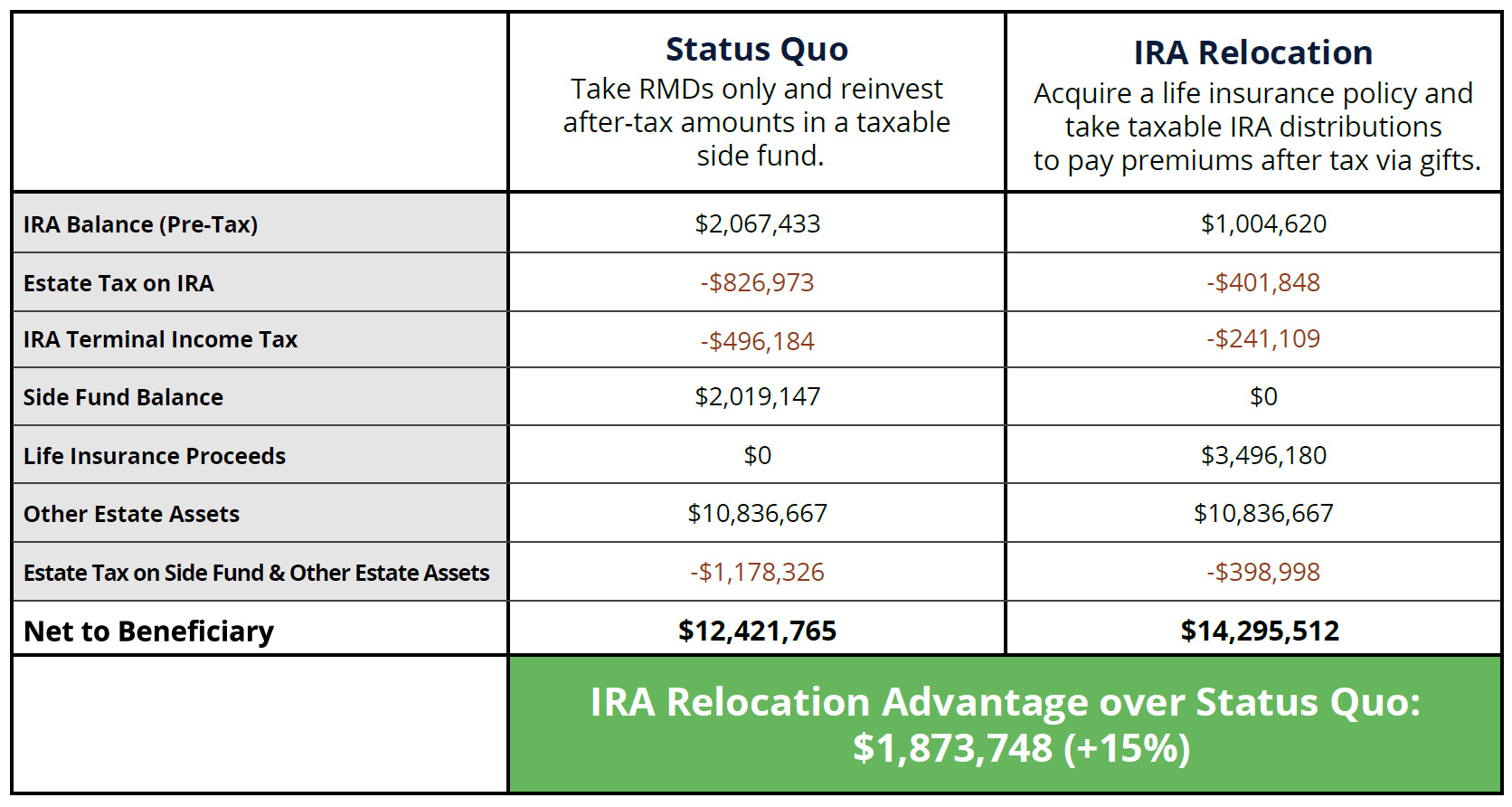Case Study: Taking Distributions to Fund Trust-Owned Life Insurance and Mitigate Income and Estate Tax at Death
The Client
- Mrs. Ira, age 70 with a $8 million net worth, modest lifestyle, and more conservative risk tolerance.
- $2 million IRA account balance not needed to maintain standard of living during life.
- Wants to minimize income and estate taxes on the IRA at her death and maximize the legacy to her children and grandchildren.
The Damage: Greater Taxation of Inherited IRAs
- Such inherited account balances must now be liquidated by DBs within 10 years of the account holder’s death, and may be subject to complex, life expectancy method-based distributions annually in years 1-9 if the IRA owner died after required minimum distributions had begun.1
- Future wealth accumulation for DBs may be impaired since distributions may now be accelerated over fewer years, the beneficiary’s taxable income and marginal tax rate may be increased, and tax-deferred growth beyond 10 years is lost.
- Inherited IRAs may be subject to both income and estate tax (double taxation) after the account owner’s death.2
The Damage Control
IRA Relocation with Trust-Owned Life Insurance

Trust-owned life insurance death benefit proceeds are generally received by the trust income and estate tax free.3
- If the IRA is not needed during life, Mrs. Ira can take taxable distributions, use the after-tax amounts to pay premiums on a trust-owned policy via gifts and, thus, “relocate” the IRA value to a tax-free death benefit.4
- Doing so does not reverse the damage caused by the 10-year rule but can help control it by creating a more tax-efficient legacy, possibly increasing amounts passed on to her beneficiaries, and helping ensure greater financial security.
- The additional RMD complexities in years 1-9 after Mrs. Ira’s post-age 72 death can also be avoided with respect to the life insurance proceeds, which can be freely invested.
The Projected Results
- Status Quo: Take Required Minimum Distributions (RMDs) only and reinvest after-tax amounts in a taxable side fund.
- IRA Relocation: Acquire a life insurance policy in trust and take taxable IRA distributions to pay premiums after tax via gifts.

Download full analysis here. An example of the calculations above and the assumptions are on page two below.
An example of the calculations assuming Mrs. Ira passes away at her life expectancy, age 90:

Life insurance assumptions: John Hancock Protection IUL 24, $1,811,040 face amount, Option C Return of Premium. Annual premium of $84,257, which is the after-tax amount using the above tax assumptions, from annual IRA distributions of $123,907, which amortizes the IRA balance to $0 over 30 years using the above rate of return assumptions. Solved for face amount to carry policy to $1,000 of cash value at age 100 based on non-guaranteed charges and a 5.79% gross (no bonuses) hypothetical credited interest rate. No-lapse guarantee to year 22 (age 92) assuming premiums paid on time when due. Female, age 70, and standard plus nonsmoker. interest rate. No-lapse guarantee to year 22 (age 92) assuming premiums paid on time when due. Female, age 70, and standard plus nonsmoker.5
- Proposed regulations were released in February 2022 which, if finalized as proposed, would require annual life expectancy method-based RMDs by DBs in years 1-9 after inheriting the IRA if the account owner died after reaching his or her required beginning date for RMDs. For account holders that died on or before 12/31/2019, the pre-SECURE Act rules apply. Eligible Designated Beneficiaries (EDBs) of those who died after 12/31/2019 are excluded from the 10-year rule and remain eligible to stretch the IRA and DCP using the life expectancy method. EDBs include a surviving spouse, minor child (grandchildren are not eligible), disabled individual, or a beneficiary not more than 10 years younger than the account holder. A surviving spouse can still elect to treat the inherited IRA as his or her own (i.e., spousal rollover). Note that upon death of an EDB, or reaching the age of majority, the 10-Year rule would apply.
- Inherited IRAs may be subject to federal estate tax if the total value of transfers made by the account owner during life and at death, including the IRA, to a person other than a spouse or charity exceeds the applicable federal lifetime exclusion amount. State estate tax may also apply.
- Assumes the policy was not transferred for valuable consideration to an impermissible transferee and no other exception to the general rule of IRC § 101(a) applies. Estate tax-free treatment assumes the policy is owned by an irrevocable trust and the insured did not possess any incidents of ownership over the policy within three years of death under §§ 2042 and 2035.
- Gifts to an irrevocable trust to pay life insurance premiums on a policy owned by the trust may have gift tax consequences if the gifts exceed the sum of the transferor’s annual and lifetime gift tax exclusion amounts allocated to the transfers.
- Death benefit payments and guaranteed elements are based on the claims-paying ability of the issuing company. Non-guaranteed elements are subject to change at the issuing company’s discretion. The ability to purchase life insurance, and premiums therefor, depend on financial and medical underwriting requirements.
The “Alterra” name was coined by joining the Latin roots “alter”, the origin of the word “altruism” with “terra” meaning earth or land. This name reflects the company philosophy of “clients before profits” and providing firmly grounded advice.


